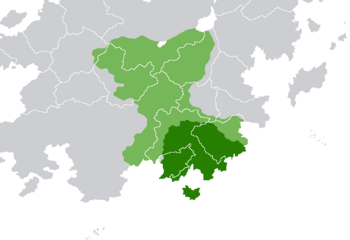Svai Empire
Svai Empire 向國 Svayhkau | |||||||||||||||||||||||
|---|---|---|---|---|---|---|---|---|---|---|---|---|---|---|---|---|---|---|---|---|---|---|---|
| 304 CE–1311 CE | |||||||||||||||||||||||
|
Flag | |||||||||||||||||||||||
 Svai Empire over modern borders. Dark green represents the core empire, light green the empire at its height in 866 CE. | |||||||||||||||||||||||
| Capital | Kantala (304-711 and 718-1214) Moumar (711-718) | ||||||||||||||||||||||
| Common languages | Svai Nieh Tchin Nainanese | ||||||||||||||||||||||
| Religion | Zohism | ||||||||||||||||||||||
| Government | Imperial absolute monarchy | ||||||||||||||||||||||
| Emperor | |||||||||||||||||||||||
• 304-316 | Stechaphnom I | ||||||||||||||||||||||
• 705-739 | Prakphan | ||||||||||||||||||||||
| History | |||||||||||||||||||||||
• Established | 304 CE | ||||||||||||||||||||||
• Disestablished | 1311 CE | ||||||||||||||||||||||
| |||||||||||||||||||||||
The Svai Empire (Svai: 向國 Svayhkau, called 暹末 Shangean: Xiānmò by the Sun and Tao dynasties) was an empire in Southeast Coius which lasted from the 4th to 14th centuries. It was created by Stechaphnom I in 304 CE after a successful revolt against the Sun dynasty, which had ruled the area since 155 CE. Until the 7th century CE it was largely confined to the Lueng and Moei river valleys, and afterwards it conquered and subjugated parts of modern-day Nainan, Zomia, and Shangea. It reached its zenith during the 9th century when the Tagamic Migration devastated the Heavenly Dominion in Pardaria and the Tao dynasty in Shangea, allowing the Svai Empire to establish a protectorate over much of the Great Steppe and Chanwa for 70 years.
During this period, known as the Venghuo Period, Svai culture flourished as it incorporated aspects of Shangean, Pardarian, Nainanese, and Dezevauan customs, literature, and philosophy from trade. It is considered a golden age of Svai artists, poets, architects, and writers. Zohism became entrenched in this period, with the system of Sengshui fully adopted to provide governance for the empire. The capital of Kantala grew to host over a million people, being the largest city in the world for a century, and the Svai emperors patronised over a thousand temples in the capital alone.
The 10th century saw the beginning of the end for the Venghuo Period. The Svai Court further retreated from governance, leaving rule in the hands of Zohist monks. With a lack of support from a stagnant and corrupt central military, the monks turned to the Oknya, local gentry, who were allowed to raise militias. Over time the Oknya took power from the monks and cemented themselves as regional warlords, focusing on increasing their power-bases at all costs. During this Peanchao period banditry ran rampant and the empire shrank dramatically. The Oknya encouraged the Kasi Migrations by hiring Kasi as mercenaries and settling them in garrison towns. This policy would prove disastrous as the Kasi would later revolt and establish their own kingdoms, gaining control of much of the Lueng and Moei river valleys.
The Svai Empire would continue on as a rump state until the Sack of Ourieng in 1311 by the Kingdom of Sippom.

